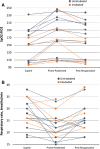Tolerability and safety of awake prone positioning COVID-19 patients with severe hypoxemic respiratory failure
- PMID: 32803468
- PMCID: PMC7427754
- DOI: 10.1007/s12630-020-01787-1
Tolerability and safety of awake prone positioning COVID-19 patients with severe hypoxemic respiratory failure
Abstract
Purpose: Prone positioning of non-intubated patients with coronavirus disease (COVID-19) and hypoxemic respiratory failure may prevent intubation and improve outcomes. Nevertheless, there are limited data on its feasibility, safety, and physiologic effects. The objective of our study was to assess the tolerability and safety of awake prone positioning in COVID-19 patients with hypoxemic respiratory failure.
Methods: This historical cohort study was performed across four hospitals in Calgary, Canada. Included patients had suspected COVID-19 and hypoxic respiratory failure requiring intensive care unit (ICU) consultation, and underwent awake prone positioning. The duration, frequency, tolerability, and adverse events from prone positioning were recorded. Respiratory parameters were assessed before, during, and after prone positioning. The primary outcome was the tolerability and safety of prone positioning.
Results: Seventeen patients (n = 12 ICU, n = 5 hospital ward) were included between April and May 2020. The median (range) number of prone positioning days was 1 (1-7) and the median number of sessions was 2 (1-6) per day. The duration of prone positioning was 75 (30-480) min, and the peripheral oxygen saturation was 91% (84-95) supine and 98% (92-100) prone. Limitations to prone position duration were pain/general discomfort (47%) and delirium (6%); 47% of patients had no limitations. Seven patients (41%) required intubation and two patients (12%) died.
Conclusions: In a small sample, prone positioning non-intubated COVID-19 patients with severe hypoxemia was safe; however, many patients did not tolerate prolonged durations. Although patients had improved oxygenation and respiratory rate in the prone position, many still required intubation. Future studies are required to determine methods to improve the tolerability of awake prone positioning and whether there is an impact on clinical outcomes.
RéSUMé: OBJECTIF: Le positionnement ventral des patients non intubés atteints de coronavirus (COVID-19) et d’insuffisance respiratoire hypoxémique pourrait éviter de devoir les intuber et améliorer leurs pronostics. Nous ne disposons toutefois que de peu de données concernant la faisabilité, la sécurité et les effets physiologiques d’un tel positionnement. L’objectif de notre étude était d’évaluer la tolérabilité et la sécurité du positionnement ventral éveillé chez des patients atteints de la COVID-19 et d’insuffisance respiratoire hypoxémique. MéTHODE: Cette étude de cohorte historique a été réalisée dans 4 hôpitaux de Calgary, au Canada. Les patients inclus avaient une suspicion de COVID-19, souffraient d’insuffisance respiratoire hypoxique nécessitant une consultation à l’unité de soins intensifs (USI), et ont été positionnés sur le ventre éveillés. La durée, la fréquence, la tolérabilité et les événements indésirables liés au positionnement ventral ont été enregistrés. Les paramètres respiratoires étaient évalués avant, pendant et après le positionnement ventral. Les critères d’évaluation principaux étaient la tolérabilité et la sécurité du positionnement ventral. RéSULTATS: Dix-sept patients (n = 12 USI, n = 5 à l’étage) ont été inclus entre avril et mai 2020. Le nombre médian de jours de positionnement ventral était de 1 (fourchette 1-7) et de 2 sessions (fourchette 1-6) par jour. La durée médiane du positionnement ventral était de 75 min (fourchette, 30-480). La saturation en oxygène périphérique médiane en position dorsale était de 91 % (fourchette, 84-95) et de 98 % (fourchette 92-100) en position ventrale. Les obstacles à une durée prolongée de la position ventrale étaient la douleur / l’inconfort général (47%) et le delirium (6%). Au total, 47 % des patients n’ont fait état d’aucun obstacle. Sept patients (41 %) ont nécessité une intubation, et deux patients (12 %) sont décédés. CONCLUSION: Dans un petit échantillon, le positionnement ventral de patients non intubés atteints de COVID-19 et d’hypoxémie grave était sécuritaire, mais plusieurs patients n’ont pas toléré cette position pour une durée prolongée. Bien que l’oxygénation et la fréquence respiratoire des patients étaient améliorées en position ventrale, bon nombre ont tout de même nécessité une intubation. Des études futures sont nécessaires afin de déterminer quelles méthodes amélioreraient la tolérabilité du positionnement ventral éveillé et si cette position a un impact sur les devenirs cliniques.
Keywords: COVID-19; case series; hypoxemic respiratory failure; intubation; prone positioning.
Figures

References
-
- Bamford P, Bentley A, Dean J, Whitmore D, Wilson-Baid N. ICS guidance for prone positioning of the conscious COVID patient 2020. United Kingdom: Intensive Care Society. 2020. Available from URL: https://emcrit.org/wp-content/uploads/2020/04/2020-04-12-Guidance-for-co... (accessed August 2020).
Publication types
MeSH terms
LinkOut - more resources
Full Text Sources
Medical
Miscellaneous

